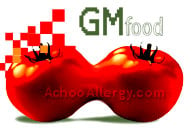
The Struggle with Genetically Modified Food
Recently there have been several stories highlighting the FDA and its struggle with genetically altered animals. This subject reaches into a variety of areas including health, environmental, and ethical. For allergy sufferers, there are a few interesting prospects, with the most written about being reduced-allergen milk. No matter how you feel about this subject, there are many sides to the very complicated issues of genetically modified food, GMOs, and labeling.
Though it’s not as widely publicized as genetically modified crops, there is a wide range of projects that have begun in the last two decades. From cows with hypoallergenic milk and salmon that are three times the size of the natural counterpart to hogs that digest plants more efficiently and other pigs that are bred to develop muscular diseases so effective treatments can be tested, there are genetically modified (GM) animals being created across the globe. For many the most basic question is, just because we can, should we?
The Risk/Reward with GMOs
In addition to regulations, which are almost non-existent at this point, there are many concerns with genetically modified animals. The long term impact of genetically modified animals is not fully known. There has simply not been enough time and research devoted to potential, long term environmental implications. Their interaction and impact on the ecosystem are not fully understood. The same argument can be made for much their impact on human health. Studies have shown no adverse effects from consuming genetically modified food, but even these are contentious as many have been funded by the producers of GMOs or those vested in the promotion of genetically modified food. While in the short term, the idea of allergen-free milk sounds wonderful, only time and research will show any long term effects of consuming that product.
Beyond this, there are moral and ethical implications that many struggle with. While few would argue against testing new treatments to fight  catastrophic diseases, genetically modified animals complicate this issue. Is it ethical to produce and raise an animal that has been modified to develop muscular dystrophy, solely for the purpose of testing treatments of that disease on it? Would it be ethical to genetically alter the make up on an animal so that it more closely resembles that of a human and would thus provide a better idea of how successful this treatment might be? These are just two examples, but questions like these raise serious concerns, blurring moral and ethical lines. Even these examples are somewhat benign given the possibilities that techniques like CRISPR – a groundbreaking genome editing tool that can literally bring the science fiction idea of genetically modified humans to life.
catastrophic diseases, genetically modified animals complicate this issue. Is it ethical to produce and raise an animal that has been modified to develop muscular dystrophy, solely for the purpose of testing treatments of that disease on it? Would it be ethical to genetically alter the make up on an animal so that it more closely resembles that of a human and would thus provide a better idea of how successful this treatment might be? These are just two examples, but questions like these raise serious concerns, blurring moral and ethical lines. Even these examples are somewhat benign given the possibilities that techniques like CRISPR – a groundbreaking genome editing tool that can literally bring the science fiction idea of genetically modified humans to life.
Walking this idea back, genetically modified organisms in the food supply is not necessarily new. Corn and soybeans that are genetically modified to produce higher yields and to be resistant to pests have been in use for many years and are commonly found in most processed foods. One advantage of these crops is that they are surprisingly “eco-friendly”. Because a seed is genetically modified to naturally produce an insecticide, growers spend less money and time on spraying their crops. This means, at least theoretically, that there is less pesticide or insecticide residue and runoff leaching into the soil and water table. That’s a win for the environment right? Possibly. However, since the level of this natural pesticide would be elevated, what is the long term effect on consuming higher quantities of it? A negative human health impact? No impact at all? We simply do not know. Questions like this linger. As we circle back to what was mentioned earlier about genetically modified food being used for many years, likely one of the most frightening aspects is that at this point more than 3/4 of all the corn grown in the U.S. has been modified. Cotton and canola are also two crops where the vast majority that is grown in the U.S. is genetically modified. Other crops like wheat are also seeing a larger and larger share of the total portion grown being genetically modified.
Genetically Modified to be Allergen Free!
 In the case of the “hypoallergenic” milk, the benefit of producing an allergen-free diary product could be enormous. The study, done in New Zealand (a leader in genetic modification), showed a complete absence of beta-lactoglobulin (BLG), a protein found in milk that can trigger an allergic reaction. Unfortunately, that same milk showed elevated levels of casein, another common culprit in diary allergies. Casein is important in the production of cheese, so while this discovery may be good in that regard, there is still much to learn. On a side note, Daisy, the cow which produced this milk, was born with no tail!
In the case of the “hypoallergenic” milk, the benefit of producing an allergen-free diary product could be enormous. The study, done in New Zealand (a leader in genetic modification), showed a complete absence of beta-lactoglobulin (BLG), a protein found in milk that can trigger an allergic reaction. Unfortunately, that same milk showed elevated levels of casein, another common culprit in diary allergies. Casein is important in the production of cheese, so while this discovery may be good in that regard, there is still much to learn. On a side note, Daisy, the cow which produced this milk, was born with no tail!
It is relatively unknown how the different protein compounds found in diary milk interact and what role each plays, but this is another important step in drilling down on how the complex elements in something as simple as milk interact with each other and with the human body. Though the milk is ultimately not “hypoallergenic”, this is promising for those who suffer from food allergies. Could you imagine, an allergy free peanut or shellfish? With an increasing number of parents across the U.S. struggling with potentially life-threatening food allergic children, is this endeavor not worth the time and effort?
To Label or Not to Label, That Is the Question with GMOs
The FDA has been slow to approve genetically modified animals. The best known example of this is a salmon produced by AquaBounty Technologies. Initially approved a couple years ago, they are still awaiting final FDA approval. In a new area, regulations and rules can be difficult to create. There is a balance that regulatory agencies, like the FDA, try to strike between protecting the well being of the public and not stifling innovation and growth or preventing helpful products from reaching market. The delay in final approval of these salmon is not out of the ordinary though. Though GM crops have been in use in the American food supply for years, there is yet to be any consensus of whether or not the products even need to be labeled as GM.
 In California a battle was waged over the labeling of food that has GM ingredients. Major food producers and companies like Monsanto, Kellog’s, PepsiCo and Dupont poured tens of millions into fighting, and ultimately defeating, the labeling initiative, Proposition 37. They argued that the expense is burdensome and that this type of regulation was not necessary. On the other side were consumer groups and independent organic food producers that favored the “right to know”. It is worth noting that dozens of countries that do use genetically modified food have regulations in place that require labeling of products that contain these ingredients. Other countries still, like Scotland, have outright banned growing genetically modified food. With a U.S. food market that surpasses $1 trillion spent annually, there was a lot at stake, both for food producers and for the consuming public. And while the debate over GM animals is receiving attention, why have GM crops largely been ignored, particularly when many of the same pros and cons that spring from the animal debate also hold true for plants?
In California a battle was waged over the labeling of food that has GM ingredients. Major food producers and companies like Monsanto, Kellog’s, PepsiCo and Dupont poured tens of millions into fighting, and ultimately defeating, the labeling initiative, Proposition 37. They argued that the expense is burdensome and that this type of regulation was not necessary. On the other side were consumer groups and independent organic food producers that favored the “right to know”. It is worth noting that dozens of countries that do use genetically modified food have regulations in place that require labeling of products that contain these ingredients. Other countries still, like Scotland, have outright banned growing genetically modified food. With a U.S. food market that surpasses $1 trillion spent annually, there was a lot at stake, both for food producers and for the consuming public. And while the debate over GM animals is receiving attention, why have GM crops largely been ignored, particularly when many of the same pros and cons that spring from the animal debate also hold true for plants?
One possible reason why plants have largely been ignored is because quite simply, they are plants. The perception of genetically altering a plant is much different than doing the same for an animal. We fundamentally think of plants differently than we do animals, and for many, the leap from genetically altering a plant vs. human is a bigger stretch than the gap between genetically modifying an animal vs. a human. Lastly, GM plants are processed and turned into food that is largely unrecognizable. It’s not often that someone opens a box of cereal and thinks of wheat. This helps to keep the thought of genetically modified ingredients, particularly when coupled with a lack of labeling, out of mind.
And none of this touches on legal battles that have been waged over genetically modified seeds. Large corporations like Monsanto and Dupont have sued farmers holding over seeds of genetically modified crops for the following year’s planting. The corporations patent the seed, then require farmers to sign an agreement that they will not replant seeds produced from seed they purchased. Traditionally, farmers could retain a portion of seed from the previous year to plant for the next, but doing so with modified seed is technically patent infringement and theft. The fact that these corporations HAVE sued farmers for this leaves a bad taste in many people’s mouth.
Regardless of where you stand on this very complex issue, there are countless factors to consider. The health effects can be far reaching, but both immensely positive and negative. For those who suffer from disease or severe allergies, the upside of genetically modified food can be transformative – a possible cure to debilitating or degenerative conditions. On the other side is unknown negative consequences, severe damage to the environment or rise in new health problems to replace those that might be solved. The debate will continue, and while many of these issues may never be resolved, traditional methods of allergy relief remains an effective alternative.
For more information on how diet and food can play a role in allergies, asthma, and other allergic disease,
✔ Probiotics and Allergies
✔ The Atopic March & Probiotics
✔ Foods That Fight Allergies or Aggravate Them
✔ Treat Eczema With Omega 3s
✔ Nutrition for Allergy Sufferers
✔ Treat Food Allergies with Supplements
Author: K. Gilmore
